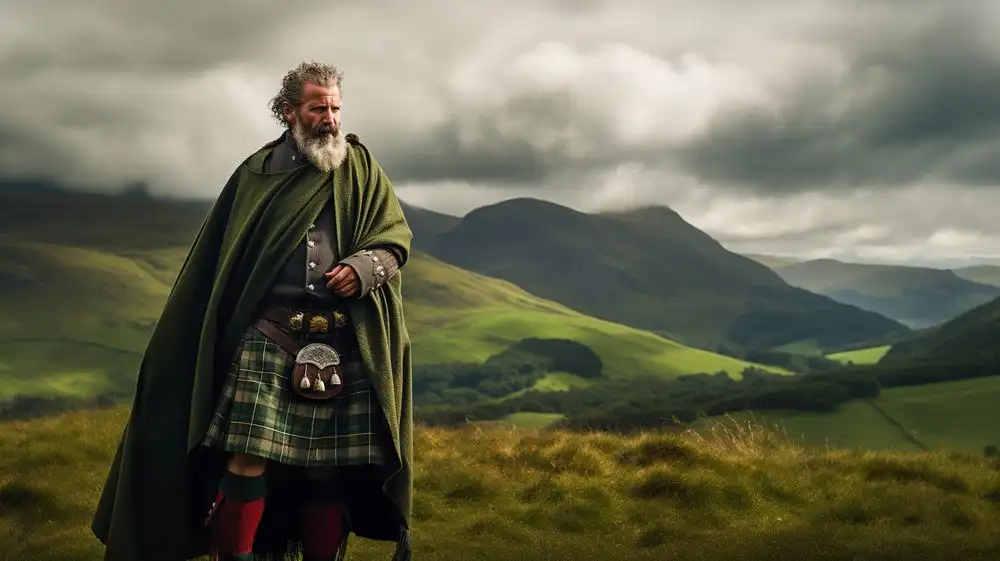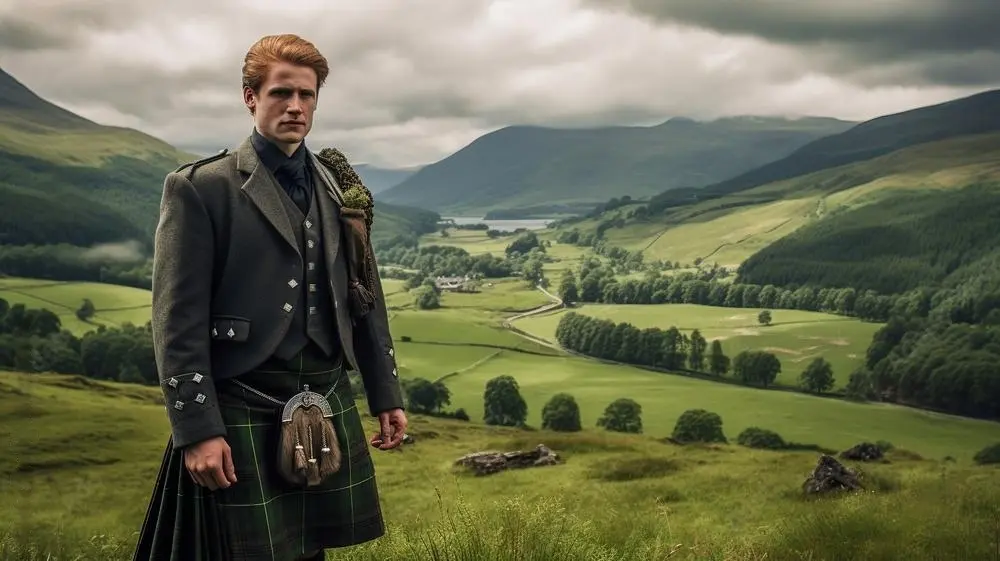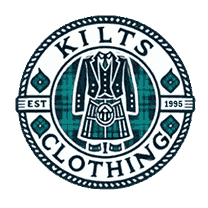The Traditional Kilt: Exploring Its Rich History, How to Wear It, and Cultural Importance

A traditional kilt is more than just a piece of clothing—it's a living symbol of heritage, culture, and pride passed down through generations. Originating in Scotland, the kilt is a knee-length garment made from woolen fabric, featuring a distinct tartan pattern representing clan or family identity.
This garment is deeply intertwined with Scottish and Irish history, and its significance extends far beyond its aesthetic appeal. Today, kilts are worn during formal occasions, cultural events, and even as part of modern fashion, reflecting a unique blend of tradition and contemporary style.
Origins and History of the Kilt
The traditional kilt for men origins can be traced back to the 16th century in the Scottish Highlands. The earliest form, known as the "Great Kilt" or "failed mor," was a large piece of fabric, approximately 12 to 16 feet long. It was draped around the body in various ways, serving as clothing and as a blanket or protective cover. The Great Traditional Kilt was versatile and practical, suited to the rugged Highland environment.
Historical Evolution: By the 18th century, the kilt had evolved into the "Small Kilt" or "feileadh beag," which is more akin to the modern kilt. This version wrapped around the waist and featured sewn-in pleats, making it easier to wear and more tailored in appearance. The Small Kilt became popular among Scottish clans. Eventually, it became a symbol of Scottish identity, especially during times of conflict such as the Jacobite uprisings.
Cultural Impact: The wearing of kilts was banned in Scotland following the defeat of the Jacobite forces at the Battle of Culloden in 1746. This ban, imposed by the Dress Act, aimed to suppress Highland culture. However, the kilt survived as a symbol of resistance and resilience. When the ban was lifted in 1782, the kilt experienced a resurgence, becoming a symbol of national pride and Scottish identity.
Traditional Kilt Components
A traditional Scottish kilt is composed of several key components, each contributing to the garment's function and cultural significance:
- The Kilt Fabric: The fabric of a traditional kilt is typically made from wool and features a tartan pattern. Tartan is a distinctive plaid design unique to each clan, region, or organization. The colors and patterns of tartan are carefully chosen to represent specific elements of the wearer's heritage.
- Pleats: The pleats are an essential feature of the kilt, usually located at the back. These pleats allow for greater freedom of movement while maintaining the kilt's structured appearance. The pleats are often knife-edged and sewn in place to create a consistent and polished look.
- Waistband and Fastening: The waistband of a kilt typically includes leather straps and metal buckles to secure it in place. The men's traditional kilts should fit snugly around the waist and hips, resting just above the navel. The fit is crucial for comfort and aesthetics, as a well-fitted kilt enhances the overall appearance.
- Sporran: The sporran is a traditional pouch worn at the front of the kilt. Since kilts lack pockets, the sporran is a practical accessory for carrying personal items. Sporrans come in various styles, from simple leather designs to more elaborate ones adorned with fur and metalwork. The choice of sporran often depends on the formality of the occasion.
- Kilt Pin: The kilt pin is both a functional and decorative item. It is typically placed on the lower corner of the kilt's front apron to add weight and prevent it from lifting in the wind. The kilt pin can be a simple design or a more elaborate piece of jewelry, often reflecting the wearer's personal style or clan affiliation.
- Kilt Shoes and Socks: Ghillie brogues are the traditional shoes worn with a kilt. These shoes are characterized by their long laces wrapped around the ankles and tied securely. Kilt hose, or socks, are worn just below the knee and are often held in place with flashes—small ribbons that add a touch of color and help secure the socks.
Types of Kilts
Kilts come in various types, each designed for different occasions and levels of formality:
- Traditional vs. Modern Kilts: Traditional kilts are made from tartan wool and follow the classic style. In contrast, modern kilts may use different fabrics and patterns to cater to contemporary fashion tastes. Modern kilts are often more lightweight and may include pockets, making them suitable for casual wear or outdoor activities.
- Dress Kilt vs. Casual Kilt: Dress kilts are worn for formal occasions such as weddings, ceremonies, and other special events. They are typically paired with a Prince Charlie jacket, sporran, and a full accessories set. On the other hand, casual kilts are simpler in design and ideal for everyday wear or less formal gatherings. Casual kilts may be worn with a simple shirt and minimal accessories.
- Great Kilt vs. Small Kilt: The Great Kilt, or "failed more," is the kilt's original form, consisting of a large piece of fabric that can be draped and fastened in various ways. The Small Kilt, or "feileadh beag," is the more modern version that wraps around the waist with sewn-in pleats for a tailored look. The Small Kilt is the most commonly worn style today.
Kilt Accessories
The accessories that accompany a kilt are crucial to completing the traditional look. These items are not only decorative but also functional:
- Belt and Buckle: The kilt belt is typically wide and often features a decorative buckle. It is worn over the kilt's waistband to help secure the garment and add a finishing touch. The buckle design can be simple to elaborate, often reflecting Celtic or clan motifs.
- Kilt Flashes: Flashes are small ribbons worn around the upper part of the kilt hose. They add a pop of color and are used to hold the socks in place. Flashes can be matched to the tartan of the kilt or chosen in a contrasting color for added visual interest.
- Kilt Jacket: The jacket worn with a kilt varies depending on the occasion. The Prince Charlie jacket is the most formal option, often paired with a waistcoat and bow tie for weddings and evening events. The Argyll jacket is more versatile and can be dressed up or down depending on the occasion. It is suitable for both formal and semi-formal events.
- Sgian Dubh: The Sgian Dubh is a small, traditional knife tucked into the top of the kilt hose, with only the handle visible. While it is mostly ceremonial today, the Sgian Dubh was historically a weapon for self-defense. The knife's handle is often decorated with clan symbols or other meaningful designs.

How to Wear a Traditional Kilt
Wearing a kilt correctly is essential to maintaining its appearance and honoring its cultural significance. Here are some key points to consider:
- Proper Kilt Length and Fit: The kilt should fall to the middle of the knee, with the waistband sitting just above the navel. The fit should be snug around the waist and hips but allow for comfortable movement. A well-fitted kilt enhances the wearer's posture and silhouette.
- How to Fold and Pleat: Ensure the pleats are neatly arranged at the back when putting on the kilt. The front apron should overlap cleanly, with the kilt pin placed just below the sporran on the right-hand side. The pleats should be knife-edged and consistent in width for a polished appearance.
- Securing the Kilt: The kilt is secured using the straps and buckles on the waistband. Ensure the kilt is tightly fastened to prevent slipping or sagging throughout the day. The sporran should be centered at the front, just below the waistband.
Cultural Significance of Tartan
Tartan is a vital aspect of the kilt, representing family, clan, or regional identity. Understanding tartan is key to appreciating the cultural depth of the kilt:
- Understanding Tartan Patterns: Each tartan design is associated with a specific clan, region, or institution. The colors and patterns are not arbitrary; they carry symbolic meaning and are often passed down through generations. For example, certain colors may represent the landscape of a clan's homeland. At the same time, specific patterns may honor historical events or figures.
- Clan Tartans and Family Heritage: Wearing a clan tartan signifies allegiance to a particular family or group. Clan members traditionally wear the tartan associated with their family name. However, some tartans are universal or "district" tartans, which anyone with ties to a specific region or community can wear.
- Modern Uses of Tartan: While tartan is most commonly associated with kilts, it has found its way into various aspects of fashion and design. Tartan patterns are used in scarves, ties, and even home decor, allowing people to celebrate their heritage daily. Tartan is also used in corporate branding and uniforms, symbolizing a connection to Scottish culture.
Traditional Kilt for Ceremonies and Events
Kilts are a popular choice for formal events and cultural celebrations. Their versatility and symbolic value make them suitable for a wide range of occasions:
- Weddings and Formal Occasions: Wedding kilts are a traditional choice for grooms and groomsmen, often paired with a Prince Charlie jacket, waistcoat, and sporran. The choice of tartan can add a personal touch to the ceremony, with many couples choosing a tartan that represents their family or a shared connection. Wedding kilts are typically more ornate and may feature additional accessories such as a kilt pin or Sgian Dubh.
- Highland Games and Cultural Festivals: The kilt is an iconic garment at Highland Games, where it is worn by participants and spectators alike. These events celebrate Scottish culture and heritage through athletic competitions, music, and dance. Wearing a kilt at a Highland Games event is a way to show pride in Scottish ancestry and connect with a larger community.
- Military and Regimental Kilts: The kilt is an official uniform in many Scottish regiments, symbolizing honor and tradition. Regimental kilts are made in specific tartans associated with the regiment, often featuring unique details such as special pleating or badges. These kilts are worn during ceremonial occasions, parades, and other formal military events.
Care and Maintenance of a Kilt
Proper care is essential to preserve the quality and appearance of a kilt. With the right maintenance, a kilt can last for generations:
- Cleaning and Storage: Kilts should be dry-cleaned to preserve the wool and tartan pattern. Machine washing can damage the fabric and cause the colors to fade. Kilts should be stored hanging to maintain their shape and avoid creases when not used. A kilt hanger is advisable to support the kilt's weight evenly and prevent stretching.
- Repairing and Restoring Kilts: Over time, kilts may require repairs, such as fixing pleats or replacing worn buckles. It's important to have these repairs done by a professional kilt maker or tailor who understands the construction and significance of the garment. Regular maintenance can prevent minor issues from becoming major problems.
- Preserving Tartan Colors: To keep the tartan looking vibrant, avoid exposing the kilt to direct sunlight for extended periods. Store the kilt in a cool, dry place, and consider using a garment bag for added protection. If the kilt becomes wrinkled, use a steamer rather than an iron, as direct heat can damage the wool fibers.

Popular Myths and Facts About Kilts
There are many myths and misconceptions about kilts, some of which need clarification:
- Kilts vs. Skirts: One common misconception is that kilts are simply skirts for men. However, kilts are distinct garments with a unique construction, cultural significance, and history. While kilts and skirts are worn around the waist, the kilt's pleats, tartan pattern, and ceremonial role set it apart.
- Do Men Wear Underwear Under Kilts? Traditionally, kilts were worn without underwear—a practice known as "going commando." Some still follow this tradition, but it's now a personal choice. Many men opt for comfort and modesty, wearing underwear beneath the kilt, especially in formal or public settings.
- Are Kilts Irish? While kilts are most commonly associated with Scotland, they are also worn in Ireland, particularly in regions with strong Celtic ties. Irish kilts often feature solid colors or different tartan patterns than Scottish kilts. The tradition of wearing kilts in Ireland is a more modern development influenced by Scottish culture.
Global Influence and Popularity of Kilts
The kilt has transcended its Scottish origins and gained popularity around the world, becoming a symbol of cultural pride and fashion:
- Kilts in Popular Culture: Kilts have appeared in numerous films, television shows, and even fashion runways, helping to popularize this traditional garment beyond its Celtic roots. Movies like "Braveheart" and "Outlander" have brought the kilt to a global audience, highlighting its historical and cultural significance.
- Kilts Outside of Scotland: Kilts are worn in various countries, often to celebrate Scottish or Irish heritage. In the United States, for example, kilts are commonly worn at Scottish festivals, parades, and weddings. The kilt has also been embraced by certain subcultures, such as the Renaissance fair community and the steampunk movement, where it is adapted to fit specific themes or eras.
- Modern Kilt Fashion: In recent years, kilts have seen a resurgence in modern fashion. Designers have reimagined the kilt with new fabrics, colors, and styles, making it accessible to a broader audience. Modern kilts may include pockets, adjustable waistbands, and contemporary patterns, blending tradition with innovation.
Conclusion: The Lasting Legacy of Traditional Kilts
The traditional kilt is a timeless garment with significant cultural and symbolic value. Whether worn for a wedding, a cultural festival, or as part of modern fashion, the kilt connects the wearer to a rich heritage that spans centuries. As the kilt continues to evolve and adapt to contemporary trends, it remains a powerful expression of identity and pride, ensuring its place in the cultural fabric of the future.
FAQs
A kilt is a garment steeped in cultural significance, with a specific construction involving pleats and a tartan pattern. A skirt is a more general term for a similar piece of clothing women wear with no cultural or traditional ties.
Yes, women can and do wear kilts. There are female kilt designs that are tailored to women’s measurements and styles, often called “kilted skirts.”
Choosing the right tartan depends on your heritage, personal preference, or the occasion for which the kilt will be worn. Many people opt for a clan tartan that represents their family history.
The sporran is a practical accessory for carrying personal items, as traditional kilts do not have pockets. It also adds an ornamental touch to the kilt outfit.
Kilts should be dry-cleaned and stored properly to maintain their shape and color. Avoid machine washing and hanging the kilt for long periods in direct sunlight.
Many kilt makers and online retailers offer kilt rentals for weddings, formal occasions, and cultural events. It’s important to book in advance to ensure availability.

